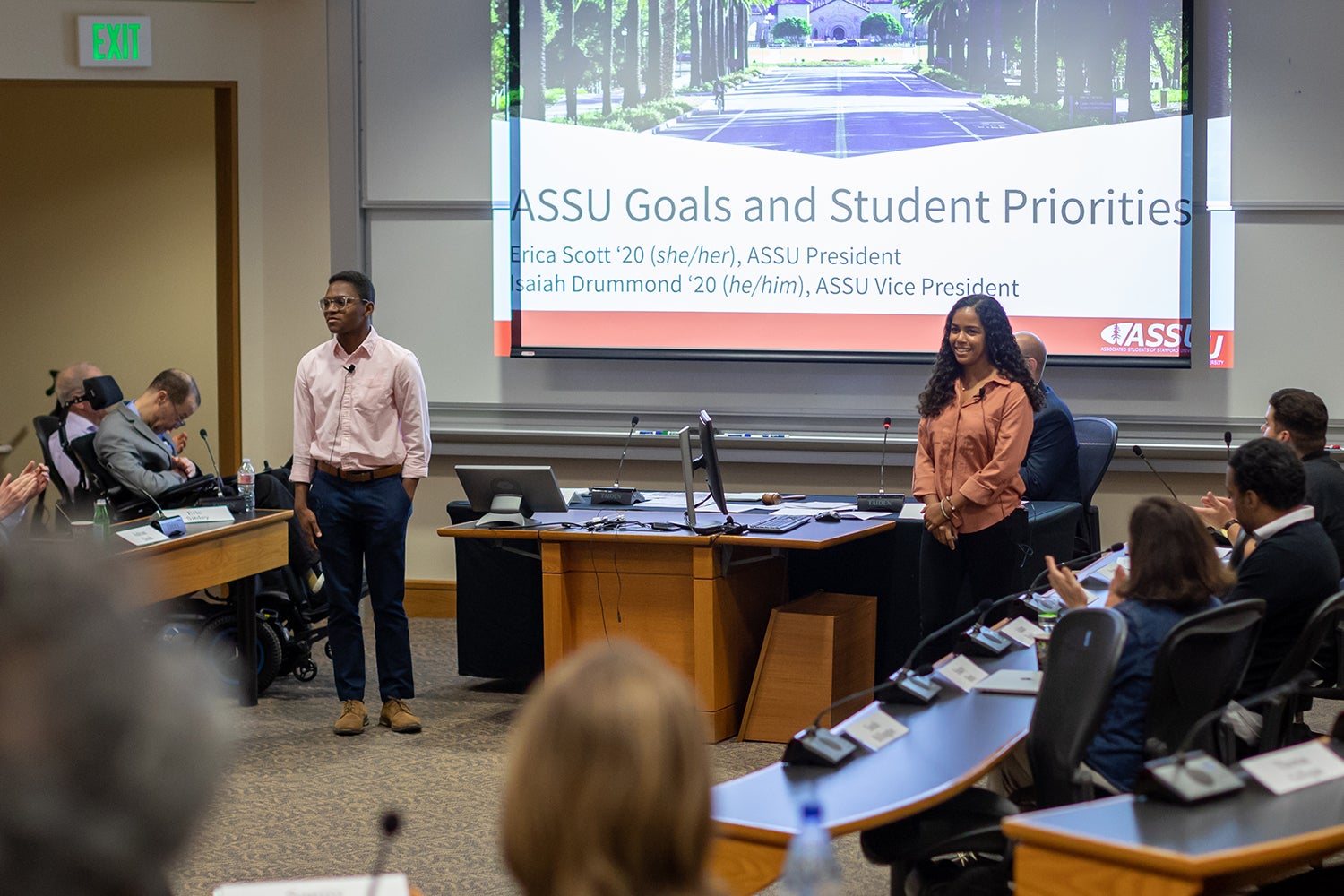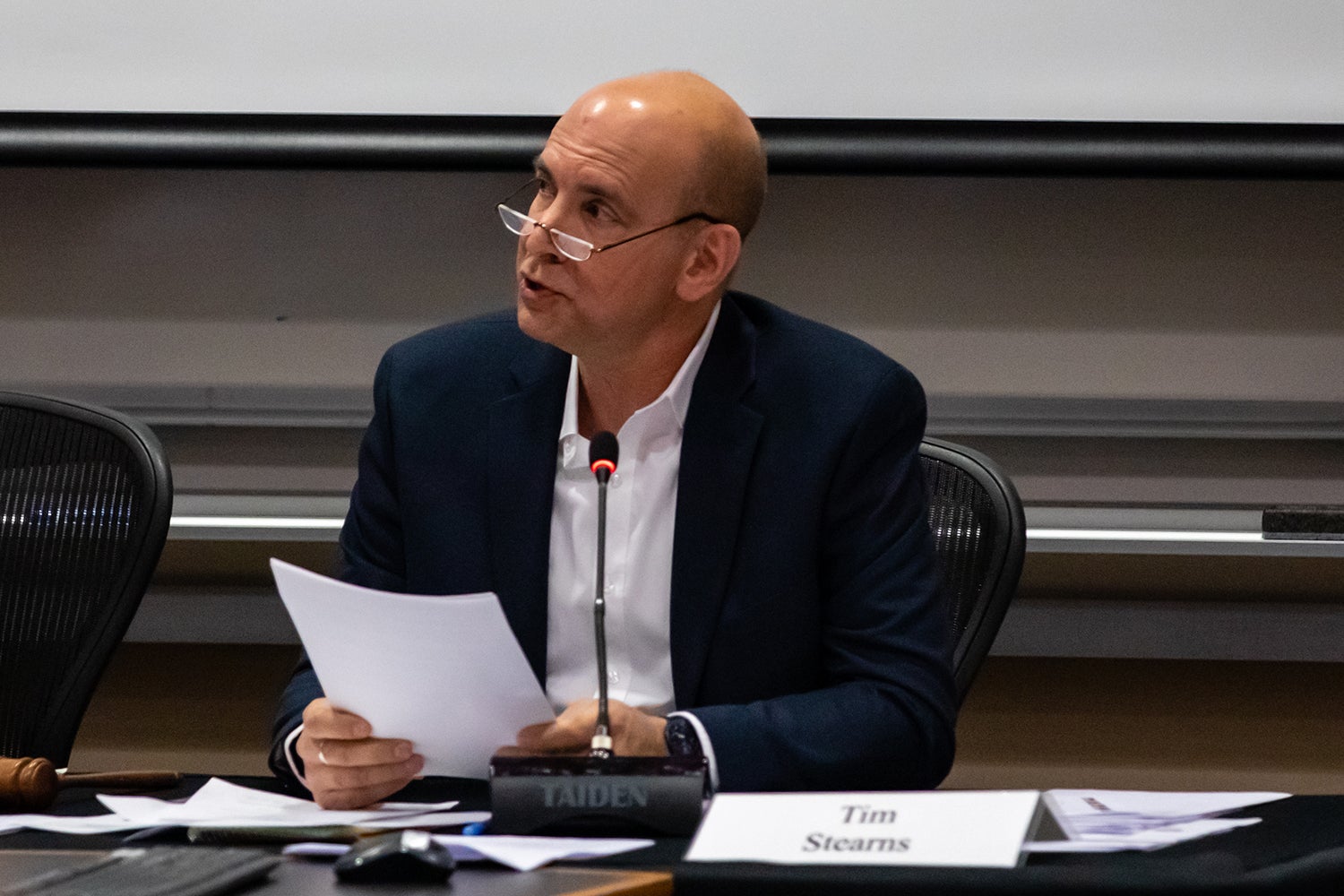Faculty Senate votes, listens to ASSU leaders, gets update on long-range vision
During its first meeting of the academic year, the Faculty Senate approved the charge to the Ad Hoc Committee on the Stanford University Press, heard presentations from ASSU leaders and received an update on the university’s long-range vision from President Marc Tessier-Lavigne.
The Faculty Senate on Thursday approved the charge to the Senate Ad Hoc Committee on the Stanford University Press, asking the group to address questions related to faculty governance and oversight of the academic nonprofit publisher.
At its first meeting of the 2019-20 academic year, the senate also heard presentations from Erica Scott, president of the Associated Students of Stanford University, and Isaiah Drummond, vice president of the ASSU.
In addition, President Marc Tessier-Lavigne gave an update on the university’s long-range vision. He also reiterated the university’s support for its international community, saying Stanford will continue to defend those who feel vulnerable.
Stanford University Press
Last June, the Faculty Senate approved the formation of an ad hoc committee “to make recommendations to the senate as to how faculty governance and faculty oversight can effectively be brought to bear on the Stanford University Press.”
At Thursday’s meeting, the senate approved the charge to the ad hoc committee on a unanimous voice vote – the second step the senate has taken to form the group. While Professor Tim Stearns, senate chair, opened the floor for five minutes of questions, there were none.
The charge said the ad hoc committee should consider (but need not be limited to) five questions regarding faculty oversight and governance of Stanford University Press (SUP):
- Should oversight of SUP be added to the charge of an existing Academic Council committee or be carried out by a new standing committee?
- If a new committee is to be formed, what should be its membership structure, including ex officio membership?
- What aspects of SUP’s operations should be considered by the committee?
- What should the relationship be between the committee and the editorial board of SUP?
- How do peer institutions address faculty oversight of their presses?
The ad hoc committee will consist of at least six faculty members from distinct departments and at least three schools, and include at least one doctoral student.
The senate ad hoc committee is the second of two faculty committees charged with recommending ways to ensure the long-term success and excellence of the Press, which has faced financial challenges in recent years.
Last spring, Provost Persis Drell formed the Stanford University Press Committee, which is chaired by Professor Judith Goldstein, chair of the Political Science Department.
That committee was charged with seeking insights from the campus community, as well as from outside experts, on various issues related to the Press, including assessing its optimal size, financial needs, fundraising potential, organizational structure, and governance and reporting relationships with the university. The committee is expected to complete its work soon.
Student leaders report
In a joint presentation, Scott and Drummond noted that students were actively involved in the process that resulted in two recent proposals recommending changes to undergraduate education at Stanford.

The senate heard presentations from ASSU leaders Isaiah Drummond and Erica Scott. (Image credit: Farrin Abbott)
The proposals – the Future of the Major, and the First-Year Shared Intellectual Experience and Exploration – came out of two design teams that were part of Our Vision, the university’s long-range planning process. The proposals will undergo faculty review in the coming months and will be discussed in-depth at a future meeting of the senate. (See related story.)
The ASSU leaders said the proposals address many important student concerns, including challenges that affect the academic success of first-generation and low-income students, and the stress associated with fitting a major into four years – an issue of particular concern to first-year students.
“Everything that’s talked about in this room actually has a real profound effect on student well-being here,” Drummond said. “We want to make sure that we’re centering student voices when we’re talking about what happens next in terms of the future of the major or the first year, as they will have an intense effect on students – not just on those who are here now, but those who will be coming for generations.”
Drummond outlined the ASSU’s policy priorities for the 2019-20 academic year, which he said fall into the categories of access and accountability, national issues beyond campus and caring for our community. Specific issues of focus include those related to free speech and academic freedom, sustainability and environmental justice, and supporting survivors of sexual violence. The leaders also noted priorities of the Graduate Student Council, including mental health and affordability.
Scott encouraged the university to increase its attention on hiring diverse faculty.
“It’s a very difficult issue that does not have an easy solution,” she said. “However, we feel it necessary to highlight this as a student priority, given that it is something that is very much on students’ radar and comes up over and over and over again as a priority that the ASSU should address.”
President’s remarks
Tessier-Lavigne said the essence of the institutional vision that has emerged from the university’s long-range planning process could be summed up in the statement: “Fueled by optimism, ingenuity and a sense of responsibility, we seek to have a meaningful impact on our world.”
In addition to strengthening support for the campus community, the plan also focuses on a compelling academic vision for Stanford, he said. It includes a series of initiatives related to accelerating the impact of research, including empowering discovery and creativity; accelerating solutions for our planet, our health and society; and embedding ethics in innovation. It also features initiatives aimed at transforming education, including renewing liberal education on campus and advancing the science of learning for all students.
“As these initiatives take shape, we’re also engaged in planning to secure the necessary financial support for many of them,” Tessier-Lavigne said. “I am excited and optimistic about what this will bring and also do for both our university community and the world.”
Turning to another topic, Tessier-Lavigne said Stanford understands concerns that have surfaced about potential misappropriation of intellectual property by foreign governments, and the implications for national and economic security. However, he said Stanford must continue protecting the integrity of its research while also pursuing the enormous benefits that come from international collaboration and exchange.
He said Stanford will continue protecting its strong, diverse international community.
“As the provost and I have stated before, we must not permit in any way, legitimate concerns about national security to bleed into a questioning of people based on their country of origin, heritage or immigration status,” he said.
“It’s contrary to our values. It’s contrary to who we are. We will continue to defend those in our community who feel vulnerable. I know that you all share this commitment to our students and colleagues who are an integral part of our community, and I want to thank you for that support. We have to work together to support all of those who feel under threat.”
The full minutes of the Oct. 10 meeting, including the discussion that followed the presentations, will be posted on the Faculty Senate website. The next senate meeting is scheduled for Oct. 24.

